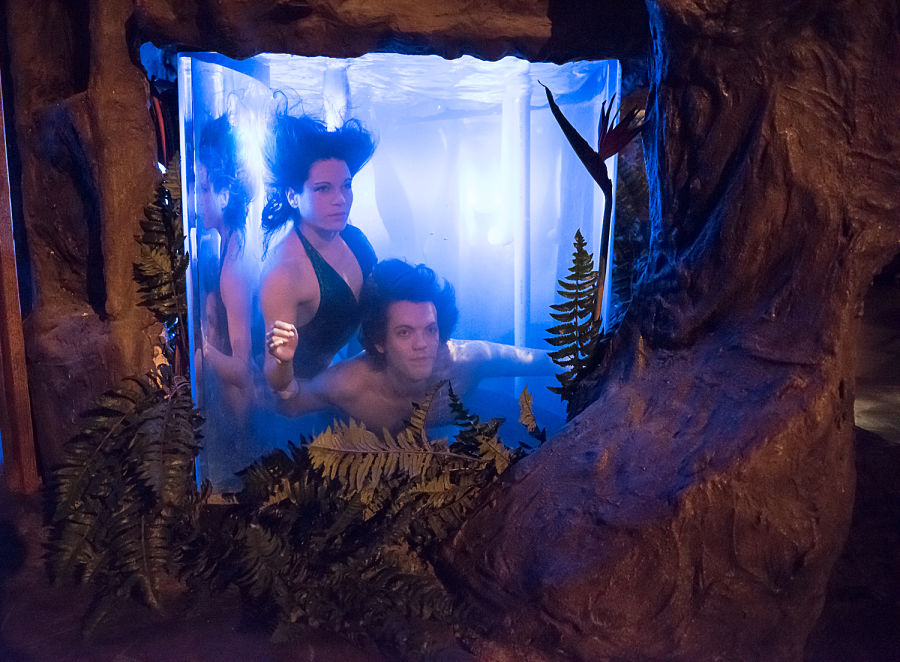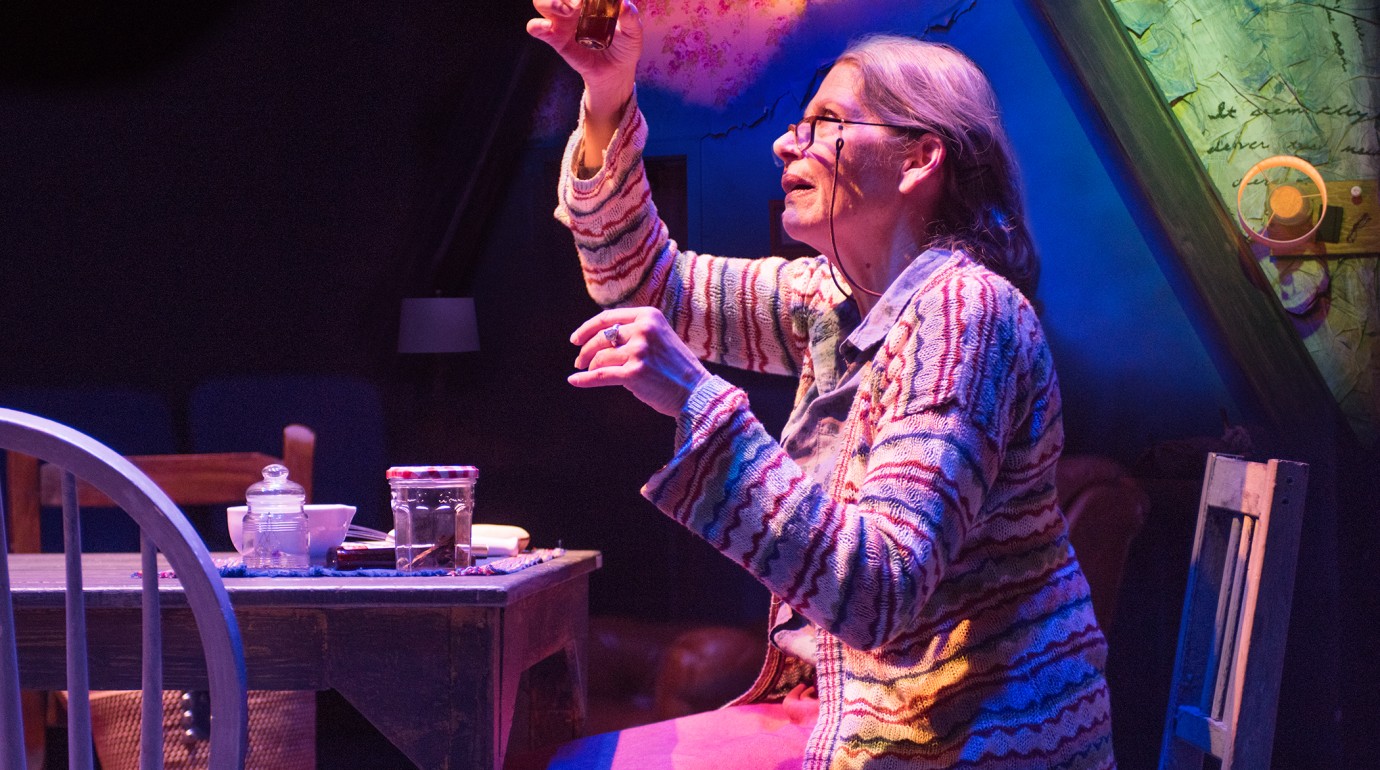I still can’t shake the smell of the blood.
It’s been a few weeks since I saw Ivo van Hove’s Broadway revival of Arthur Miller’s A View from the Bridge, which ended with a waterfall of stage blood that drenched the huddled performers, staining their all-white costumes and the all-white set. But as startling as it was to look at, it was even more unsettling to smell.
Sitting onstage just a few feet from the deluge, I felt the odor clinging to the inside of my nose and throat. It was sharp and medicinal, with a cloying sweetness underneath. This somehow evoked Eddie Carbone, the dockworker in Miller’s play who is too naïve to see how his obsession with his niece (and his own masculinity) has curdled everything around him.
Yet with the exception of the friend who sat next to me, no one I’ve talked to remembers smelling anything—even people who were in the onstage seating banks. That makes the scent even more vivid in my memory, as though it were a secret encounter in a public space. Maybe that odor wasn’t even intended to be part of my experience. Maybe it was just a byproduct of how that night’s batch of blood got made. But when I think about it, my throat still constricts.
Smells, of course, are frequently part of theatre. If an actor lights a cigarette on stage, you may tensely count the seconds until the smoke hits you in the face. If the person next to you is a little ripe, it may upend your entire reaction to a show. But sometimes, the odors in a production are not accidents or byproducts. Sometimes, they’re used on purpose, adding something discreet and meaningful to a live experience.
Let’s call it “aroma-turgy”—the conscious use of smell as a part of theatrical design. Several current productions are employing it right now, and their examples underscore both the rewards and frustrations of tickling an audience member’s nose.
Take Sagittarius Ponderosa, a new play by MJ Kaufman that runs through Feb. 28 at San Francisco’s New Conservatory Theatre Center. (It will also be produced in New York this year by National Asian American Theatre Company.) The show follows Archer (still called Angela by his family) as he meets a beguiling stranger near a Ponderosa pine tree in an Oregon forest. The play—which Kaufman has said attempts to find “a new plot form to write about gender”—is especially concerned with notions of fluidity, and that includes the fluidity between spaces. Inside and outside can become the same place, and to that end, an early stage direction suggests that when Archer first approaches the Ponderosa pine, the entire audience can smell it.
“It’s a super-distinctive smell that not everyone would recognize, but I still wanted them to have a sense of it,” Kaufman says. “It’s a super-specific, unique experience to be in a dark, forested area, and all you can smell is the butterscotch smell of this tree. I felt like that was part of the magical landscape in that scene.”
And so the production team at NCTC set about creating an aroma, eventually deciding to heat wax that’s infused with essential oil of ponderosa bark. They quickly learned how tricky smells can be to control. For one thing, who knows where the air is going to push a scent? “There are pockets of the room that smell more than others,” says Ben Randle, the production’s director. “Depending on where you are in the room, you might smell something, or you might not.”
And even people who do catch a whiff of essential oil may not notice it for long. As Randle notes: “Within a couple of seconds, you’ve absorbed it as the smell of the room. So that’s another challenge with this; it has to become more of an atmospheric component of the show, as opposed to something narrative, where you’re saying, ‘This smell happens at this exact moment, and it’s tied directly to this one event.'”
Greg Meeh echoes that insight. As the president of J & M Special Effects, he has designed scents for a variety of shows, including a blast of jasmine for Katori Hall’s Our Lady of Kibeho at Signature Theatre in New York and a “horse-like smell” for a scene featuring menacing balrogs in the musical adaptation of The Lord of the Rings. “It’s a lot easier, and less expensive and time consuming, to deliver a subliminal aroma,” he says, but he adds that even a subtle atmospheric odor has to be carefully designed.
“With Lord of the Rings, we were trying to play around with something that could be ‘spring,’ and as soon as you go there, everything you can come up with has been in some urinal or some bathroom or some disinfectant or some baby wipe,” he explains. “Scent memory can be very strong. When you have a scent with any bit of reference to something like that, you’re not eliciting the appropriate response. Unless, of course, your scene is in a urinal.”
Nor is there any guarantee that people who smell your aroma-turgy will actually grasp that it’s part of the show. Discussing those Ponderosa scents, Kaufman says, “I asked a lot of people if they smelled anything, and no one said, ‘Oh yes! I smelled pine!’ I wonder if it’s what we’re trained to recognize. If I smell something, I might not even assume it’s part of the design of my experience, but whatever light I see or sound I hear, I do.”
As elusive and frustrating as it can be, however, aroma-turgy may still be worth the effort. “It’s going to give a sense of specificity to some people, and for others, it will just trigger an emotional response,” Randle says. “Frankly, I think that’s okay.”
So does Jennine Willett, whose company Third Rail Projects is currently staging The Grand Paradise in a warehouse in Brooklyn. A fully immersive experience, the show drops audience members into a fictional beach resort in the 1970s, and in every room, there are actors and objects to interact with. Smells have been carefully curated throughout, so that, say, when patrons encounter a male hustler in a small bedroom, his pillowcase has been dabbed with vintage cologne. “Maybe it’s three people a night that walk away going, ‘Oh my God, that guy smelled just like my boyfriend in high school,'” Willett says. “But I think that’s a win. It’s great when people have a moment to connect to something from a personal space.”

She adds that the show is created to make audience members feel like protagonists, which is why everyone has the freedom to explore and interact with it on their own terms. “That’s why we go through the trouble to find these things that trigger memory and trigger a personal response,” she says. “There’s been a fascination with seeing if there’s a away to create some part of an emotion in a theatrical experience—if there’s some way to take you back to what you felt like in a particular moment. And smell is a big part of that.”
In other words, aroma-turgy can foster an incredibly intimate connection with an audience. After all, when we smell something, actual particles of an object enter our bodies. What better reminder that we’re here, now, living in the world that’s being created onstage? And if the smell provokes different associations for different people, then that just personalizes the experience of the art even more.
As an example, think of a production that lets actors cook onstage: The aroma of a meal grounds us in the immediate liveness of the moment, but it may also hurl us back to some kitchen or restaurant we’ve visited ourselves. The present and the past, the artistic and the personal, are intermingled in the odor.
Mia Katigbak, NAATCO’s artistic director, has been considering that fluid state as her company prepares its production of Sagittarius Ponderosa. “A smell conjures so many things that nothing else can,” she says. “It’s so elusive. If I smell this scent of pine, is my first thought of a Christmas tree or those awful air fresheners you put in your car? Where does the brain go? I’m excited to think about what the audience might connect to the smell, and how many different connections there can be.”




